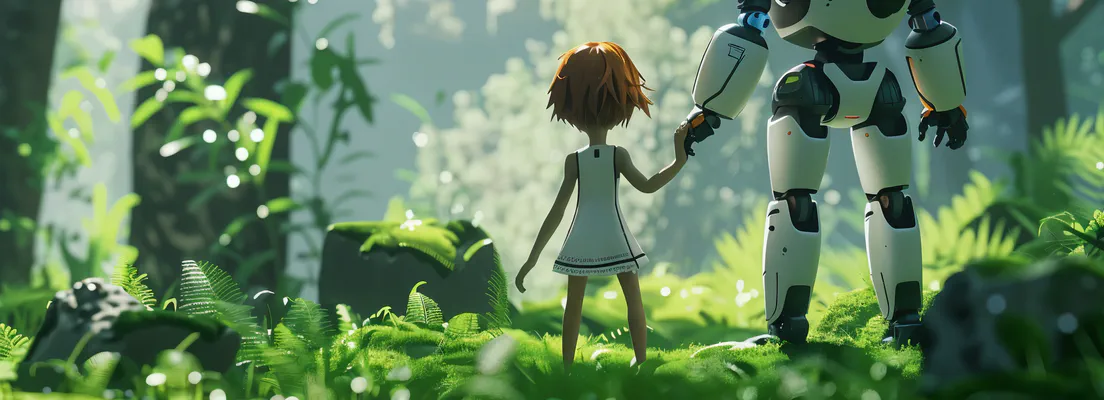A humanoid robot is a type of robot designed to resemble the human form, often featuring a head, torso, arms, and legs. These robots are engineered to perform tasks that require human-like movements and interactions, making them suitable for various applications such as customer service, healthcare, and research. Equipped with advanced sensors, artificial intelligence, and machine learning capabilities, humanoid robots can understand and respond to their environment, enabling them to assist in complex tasks or engage with people in a more relatable manner. Their design aims to enhance human-robot interaction, bridging the gap between technology and everyday life.
For years, humanoid robots have been a popular theme in science fiction , but they are now emerging as a tangible reality. Around the globe, companies are innovating advanced robotic systems aimed at enhancing operations in factories, warehouses, homes, and research environments.
The Root of Humanoid Robot
The history of humanoid robots dates back to ancient times, with myths and legends featuring artificial beings resembling humans. However, the modern concept began in the 20th century. In the 1950s and 1960s, American pioneers in robotics like George Devol and Joseph Engelberger created early industrial robots, laying the groundwork for robotic technology.
The first notable humanoid robot, WABOT-1 , was developed in Japan in 1973, capable of walking and performing simple tasks. The 1990s saw advancements with robots like ASIMO by Honda , which could walk, run, and navigate environments.
In the 21st century, companies like Boston Dynamics and Tesla have pushed the boundaries further, creating robots that can perform complex actions and interact with humans. Today, humanoid robots are being integrated into various sectors, reflecting significant advancements in AI and robotics, and paving the way for a future where they may become common companions in daily life.
The Cutting-edge Humanoid Robots
Today’s humanoid robots represent a remarkable fusion of advanced AI and cutting-edge technologies, pushing the boundaries of what machines can achieve. Equipped with sophisticated sensors and machine learning algorithms, these robots can perceive and interpret their surroundings, allowing them to navigate complex environments with agility and precision. Their humanoid design enables them to perform a wide range of tasks, from assisting in healthcare settings to engaging in customer service roles. With enhanced capabilities for speech recognition, emotional expression, and adaptive learning, these robots can interact with humans in natural and intuitive ways. As they continue to evolve, today’s humanoid robots not only exemplify technological innovation but also hold the potential to transform industries and enhance everyday life, bridging the gap between human and machine.
Below, you’ll find a collection of videos that highlight the cutting-edge technology and design of contemporary humanoid robots. These demonstrations not only illustrate their functionalities but also provide a glimpse into the future of robotics and their potential roles in our daily lives.
Boston Dynamics Atlas
The Atlas robot from Boston Dynamics stands out as one of the most sophisticated bipedal humanoid robots available today. With a height of 1.5 meters and a weight of approximately 80 kilograms, it is engineered for agility, strength, and acrobatic feats.
Atlas is specifically designed for dynamic movements, parkour, and precise locomotion techniques. It primarily functions as a research platform, exploring the frontiers of humanoid motion and control. While its capabilities are impressive, Atlas is not intended for commercial use and is not available for mass-market applications.
Tesla Optimus
The Tesla Optimus , often referred to as the Tesla Bot, embodies Elon Musk’s vision for a versatile humanoid robot capable of tackling both industrial and household tasks. At a height of 1.73 meters and weighing approximately 57 kilograms, it is engineered to handle repetitive and hazardous duties typically performed by humans in factories and homes.
Equipped with AI-driven navigation, advanced vision processing, and agile hands, Optimus is designed with the goal of achieving cost-effective mass production. However, it is still under development, with only a few limited demonstrations available in real-world scenarios.
Unitree G1
The Unitree G1 is a compact, AI-enhanced humanoid robot designed for human interaction and smart assistance. In contrast to its larger counterpart, the Unitree H1, which emphasizes agility and industrial applications, the G1 is smaller and optimized specifically for AI-driven engagement. Standing at 1.27 meters and weighing around 35 kilograms, it functions more as a robotic assistant than as a heavy-duty industrial worker.
Extra large joint movement angle space, 23~43 joint motors. Robotics technology accelerated by AI is upgrading and evolving every day. Although Unitree has not revealed details about its payload capacity or battery life, initial demonstrations indicate that the G1 can perform smooth, human-like movements and engage in speech interactions. This positions it as a promising assistant in retail, research, and educational settings.
As this article is written, the Unitree G1 humanoid AI avatar is available with a price starting at $16,000 (excluding tax and shipping costs).
OneX Technologies NEO Gamma
NEO Gamma is the next generation of home humanoids designed and engineered by 1X Technologies. The Gamma series includes improvements across NEO’s hardware and AI, featuring a new design that is deeply considerate of life at home.
The NEO Gamma is a safe and intelligent humanoid robot crafted for seamless integration into human environments. Although the specific payload capacity and battery life are not disclosed, the NEO Gamma emphasizes human-like movement and robust safety features.
Figure.AI Figure 02 & Helix
On August 6, 2024, Figure AI launched Figure 02, an advanced humanoid robot aimed at industrial applications. It boasts integrated cabling, a torso-mounted battery, and six RGB cameras paired with an onboard vision model. Powered by NVIDIA RTX GPU modules, it delivers three times the computing power of its predecessor. The robot features capability for conversational interactions. Its redesigned hands have 16 degrees of freedom and can carry objects weighing up to 25 kg.
Building on this, Helix offers 35 degrees of freedom, including human-like wrists and fingers. It includes Helix VLA, a neural network capable of controlling two robots at once, allowing them to respond to natural language commands and collaborate without extensive training. Figure claims Helix can pick up nearly any small household object, even those it hasn’t encountered before.
Apptronik Apolo
Introducing Apollo , a cutting-edge humanoid robot engineered for seamless operation in human environments. Towering at 1.73 meters and weighing 72 kilograms, Apollo boasts a payload capacity of 25 kilograms and a battery life of up to four hours.
Designed to revolutionize labor across various industries, Apollo incorporates advanced AI integration, flexible manipulation capabilities, and ergonomic motion. While its potential is impressive, the true measure of its success will hinge on its ability to adapt and thrive in real-world workplaces.
EngineAI PM01
The EngineAI PM01 , a next-generation humanoid robot that blends affordability, agility, and a research-centric design. Tailored for both academic and commercial applications, it acts as a versatile testbed for AI and robotics exploration. Unlike many pricey humanoids, the PM01 is open-source, empowering researchers and developers to experiment with AI models, locomotion control, and human-robot interaction.
With its highly adaptive bipedal walking gait, the PM01 mimics human movement more fluidly than traditional humanoid robots, positioning it as a promising solution for automation, service robotics, and assistive tasks.
Agility Robotics’ Digit
Agility Robotics Digit is a humanoid robot making waves in real-world applications, working 9-to-5 shifts across diverse environments. Specifically designed for warehousing and manufacturing, Digit excels at managing various material movement tasks while ensuring safety and adaptability to changing demands.
Recently upgraded with technical enhancements, Digit boasts improved operational efficiency and safety compliance, solidifying its position as a leader in automation. With its embodied AI, Digit marks a significant advancement in the integration of robotics into everyday labor, transforming the future of work.
NEURA Robotics 4NE-1
NEURA’s 4NE-1 is designed to assist humans across various domains, including households, healthcare, construction, and industrial settings. Standing at 1.80 meters and weighing 80 kilograms, 4NE-1 is equipped with advanced cognitive abilities, allowing for natural interaction through voice and gestures.
Its 3D vision capabilities enable object, environment, and gesture recognition, while integrated force-torque sensors provide a sense of touch. The robot’s design ensures safe collaboration with humans, making it a versatile assistant in daily life.
MenteeBot
MenteeBot is a humanoid robot designed to operate effectively in both household and warehouse settings. Standing 1.75 meters tall and weighing 70 kilograms, it can carry loads of up to 25 kilograms.
Equipped with advanced AI technologies, MenteeBot utilizes Sim2Real learning for realistic movement, NeRF-based real-time 3D mapping, and Large Language Models for enhanced task comprehension. Its design includes fully functional hands and agile locomotion, allowing it to perform delicate tasks and navigate complex terrains with ease.
Kepler Forerunner K2
The Kepler Forerunner K2 is emerging as a noteworthy player in humanoid robotics, especially suited for industrial and collaborative applications. With its high payload capacity, advanced dexterity, and extended battery life, it is well-equipped for tasks that demand both strength and precision.
However, its current developmental stage and limited deployment call for closer observation to evaluate its real-world performance and reliability.













